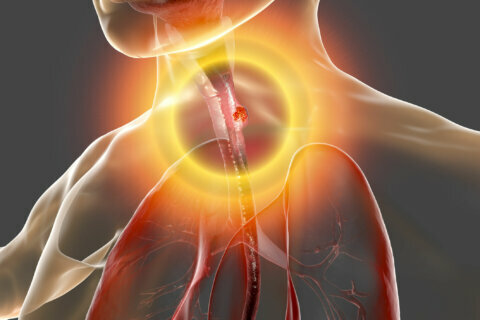WASHINGTON — “One of my favorite midnight calls, it was actually at 2 in the morning. I got a call on my Blackberry and there was a physician on the other line who was panicking.”
Samer S. Najjar, director of Heart Failure of MedStar Heart Institute at MedStar Washington Hospital Center, recounts a memorable situation from several years ago.
“He says, ‘I have this patient in front of me and she has no pulse!’ I was like, ‘Is she talking?’ and he said, ‘Yeah, she’s talking to me. It doesn’t make sense. If you have no pulse, you should be out!'”
Generally, that is the case — but not for a growing patient population at MedStar Washington Hospital Center and around the world. These patients are turning to left ventricular assist devices, or LVADS, to live with heart failure.
In 1999, DaKeia Williamson was diagnosed with heart failure after a rare complication from labor and delivery caused her coronary artery to dissect. At the time, the D.C. resident was 23.
The tear in her artery created a blockage, and Williamson underwent a quadruple bypass surgery to correct the problem.
“And then I was fine up until 2010,” says Williamson, who is now 39.
But the new mother wasn’t fine. Najjar says the blocked blood flow to her heart caused a lasting injury.
“She probably had the equivalent of a heart attack at the time,” says Najjar, who adds the damage slowly progressed over time.
Then, in January 2010, Williamson ended up back in the hospital. She was so tired she couldn’t get off the couch, and she was so sick she couldn’t keep any food down.
“Grapes, water, watermelon, whatever I tried to eat just came up. I was just almost like a vegetable … just no energy, nothing,” says Williamson, who was down to 109 pounds when she went to the hospital.
The doctors initially thought her symptoms were gastrointestinal, but after her kidneys started to shut down, Williamson was diagnosed with advanced heart failure.
Heart Failure: An Epidemic
Simply put, heart failure is when the heart can’t keep up with its workload, and thus cannot meet the body’s demand for blood and oxygen.
Every year, a couple million people are diagnosed with heart failure and there are hundreds of thousands who die of heart failure, Najjar says.
“In the lay public, heart failure is not well known. If you tell somebody you had a stroke, if you tell somebody you have a heart attack, if you tell them you have cancer, they understand that. If you tell them you have heart failure, that doesn’t sound like a bad thing,” Najjar says.
Although the prevalence of heart failure increases with age, it is not limited to the older population. Some babies are born with it, and adolescents can develop it.
According to Najjar, most patients with heart failure are treated with medication and lifestyle adjustments, but their symptoms — such as shortness of breath, swelling and fatigue — must be closely monitored, since it is easy to miss the signs of worsening heart failure.
“Often times the change occurs rather slowly that people just sort of adapt their lifestyle to match what their body will let them do and therefore they don’t notice, ‘Hey, wait a second. I am now basically house-bound,'” Najjar says.
Of the approximately 5.7 million Americans living with heart failure, roughly 10 percent progress to an advanced stage. Once patients reach this state, Najjar says there are limited options for treatment.
Some patients receive inotropes, a medication delivered by IV that causes the heart to beat stronger, and some turn to end-of-life counselling. Others opt for surgery, either for heart transplantation or an LVAD.
Until the mid-‘90s, heart transplantation was a strong candidate for treatment. It has since leveled off.
“The Achilles heel of heart transplantation has been, and will always be, the availability of donor hearts. That is what limits us,” Najjar says.
And because of the limited supply of healthy donor hearts, 10 to 20 percent of transplant candidates die while waiting for a transplant.
“If anything, it’s getting harder and harder to get hearts,” Najjar says.
Turning to Technology
The LVAD is not a new treatment option for advanced heart failure — but its growing use is making it apotential candidate to replace heart transplants for those who qualify, and to improve lives of those diagnosed with heart failure.
The LVAD was developed in the ‘70s by Dr. Michael DeBakey. Once surgically implanted in the patient, the device takes blood away from the left ventricle (the chamber of the heart that pumps blood out of the lungs and into the body) and up to the aorta (the body’s main artery), completely bypassing the function of the heart.
A tube from the LVAD exits the abdomen of the patient and connects to a battery charger.
Initially, the LVAD was developed as a bridge to transplantation — meaning it increased the chances that those on the transplant list would live long enough to receive a new heart.
Now, it’s being reconsidered as a “destination therapy.”
“Right now we only use these devices in people who have end-stage heart failure. But people are doing so well with these devices that people are starting to say, ‘Wait a second, if I am taking my end-stage heart failure and making them have a normal life, why can’t I take my Class III heart failure patients who are on these medications and make them live better,” Najjar says.
Over the years, manufacturers improved the design and function of the LVAD. Instead of having multiple parts with pumps and valves, the newer models have a rotor that turns at 9,000 RPMs. Additionally, newer models are smaller in size.
The spinning rotor is the reason why LVAD patients do not have a pulse. The heart is not “pumping” out blood in the traditional manner.
How does the LVAD compare to other treatment options for heart failure?
The average survival after a heart transplant is 12 to 13 years. This seemingly short lifespan is due to many factors, including a suppressed immune system and possible infused blockages in the heart.
“[Heart transplantation] is not a cure, so to speak,” Najjar says.
The one-year survival rate for advanced heart failure patients who just take medication is 25 percent, and the one-year survival rate for those with LVADS is around 80 percent.
“There are few times in cardiology we took something uniformly fatal and got it so much better,” Najjar says. “That is a huge game changer in the field.”
The newer models of the LVADS have only been on the market for about 10 years, and thus the average life expectancy for LVAD patients is unknown, since many continue to live with the device.
Williamson is one of them.
Living with an LVAD
When asked how much the LVAD has improved her quality of life, Williamson says, “A whole lot.”
Her surgery took place in May 2010, and by July, she was back at work. Her approach to the LVAD equipment is one of style. Williamson carries different cross-body designer bags to hold her LVAD tube and batteries.
She recently showed off her Betsy Johnson and Isabella Fiore bags to Najjar.
“During the day, it’s just two batteries that hook on either side. And then in my bag I carry an extra two batteries. So if I am going to be out the majority of the day, I just take the back-ups,” she says. “And nobody can tell I have it.”
“Yeah, we just have to write a prescription: ‘New bag for batteries,'” Najjar jokes.
While Williamson tackles her new life with style, she also discusses the limitations and complications with the LVAD.
For starters, she can’t swim, play contact sports or engage in risky activities, like riding a horse. She has to change a sterile dressing over the tube in her abdomen a few times a week, and when she needs to take a shower, her batteries go in a special shower bag.
Not to mention, a few days without power can be a big deal for her.
“If I know a storm is coming, I charge all of my batteries,” she says, adding that the power company knows to prioritize her house in the event of a power emergency.
Also, she doesn’t have a pulse, due to the continuous flow of blood through the LVAD’s rotor.
A Replacement for Heart Transplants?
Najjar predicts in the next 10 years, LVADS could be a more common answer for those with heart failure. But first, a few things must change.
For instance, he says a smaller device is necessary. This will make the surgery less invasive, and thus less risky and less expensive. Najjar hopes one day LVAD surgery could even be an outpatient procedure.
“As they get smaller and smaller, the operations get easier and easier,” he says.
Having a battery that can charge with paddles through the skin is also an important advancement. This eliminates the connection from the inside out, and thus cuts the risk of infection.
And finally, the cost of the device needs to be lowered. Najjar estimates the cost of an LVAD and its batteries is close to $100,000, not including hospitalization and surgery.
“When we have more data to support long-term use, then more people will become eligible for it, and I think as more of these are implanted, the price comes down, and as technology advances, the surgery becomes less of an issue.”
Five years ago, MedStar Washington Hospital Center performed 11 LVAD surgeries. Last year, it completed 62.
“The patient population is expanding tremendously,” Najjar says.
“… Now you have a therapy that will be there for you, and instead of having to worry about the availability of donor hearts … then this will become the primary therapy. And if you have a mechanical problem, then the bailout will become heart transplantation. But now I just stepped into 2025 or 2030.”







